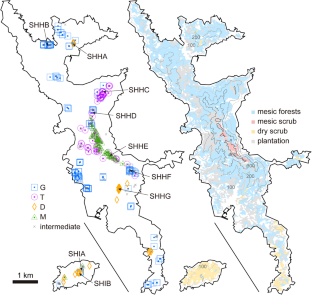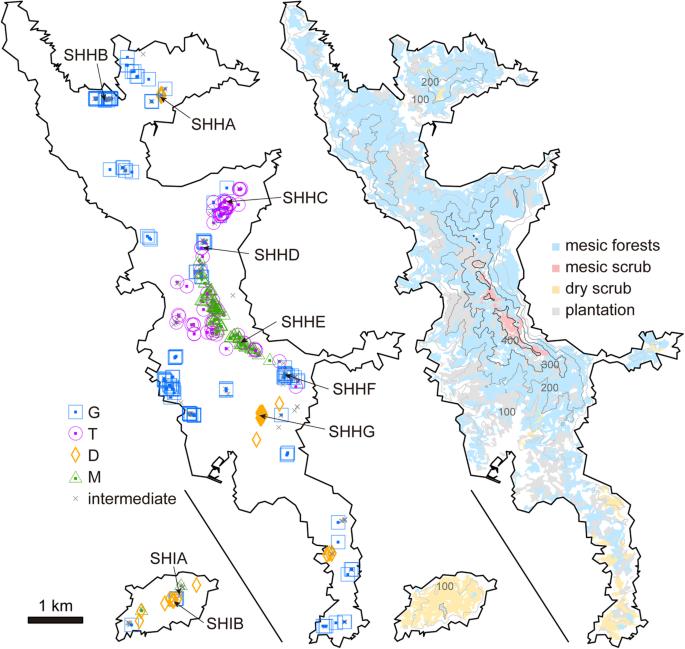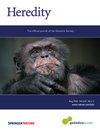Ecotype variation in the endemic tree Callicarpa subpubescens on small oceanic islands: genetic, phenotypic, and environmental insights
IF 3.1
2区 生物学
Q2 ECOLOGY
引用次数: 0
Abstract
Callicarpa subpubescens, endemic to the Ogasawara Islands, is suggested to have multiple ecotypes in the Hahajima Islands, specifically in the central part of the Ogasawara Islands. In this study, associations between genetic groups and spatial distribution, habitat, leaf morphology, size structure, and flowering time of each genetic group were investigated on Hahajima and the satellite Imoutojima Islands. Genetic groups were identified using EST-SSR markers, revealing four ecotypes named based on morphological features: Dwarf (D), Glabrescent (G), Tall (T), and Middle (M), with M being a result of the hybridization of G and T. Ecotype D, adapted to dry environments, is characterized by small tree size, dense thick leaves with abundant hairs, and is distributed in dry scrub. Ecotype G, adapted to understory of mesic forests, lacks leaf hairs. Ecotype T, adapted to the canopy of mesic forests, has hairy leaves and is tall in tree height. Ecotype M, adapted to the canopy of mesic scrub or edges of mesic forests, has hairy leaves but with a shorter tree height than ecotype T. Flowering peaks differed among all ecotype pairs except G and M, but the flowering times more or less overlapped among all ecotypes, suggesting that pre-mating isolation among ecotypes is not perfect. Post-mating isolation is considered absent, as there were no differences in the results, germination, and survival rates of one-year seedlings among inter- and intra-ecotype crossings. The existence of such ecotypes provides valuable insights into the ongoing speciation processes adapting to the oceanic island environments.


海洋小岛上特有树种 Callicarpa subpubescens 的生态型变异:遗传、表型和环境分析。
Callicarpa subpubescens是小笠原群岛特有的植物,被认为在八幡岛(特别是小笠原群岛中部)有多种生态型。本研究调查了八幡岛和卫星壬小岛上各遗传群与空间分布、栖息地、叶片形态、大小结构和开花时间之间的关系。利用 EST-SSR 标记确定了遗传组,并根据形态特征命名了四个生态型:生态型 D 适应干燥环境,特点是树体小,叶片浓密厚实,有大量绒毛,分布在干燥的灌丛中。生态型 G 适应于中度森林的林下,缺乏叶毛。生态类型 T 适应中生林的树冠,叶片有毛,树高较高。生态类型 M 适应中生灌丛或中生森林边缘的树冠,叶片有毛,但树高比生态类型 T 短。除 G 和 M 外,所有生态型对的花期都不相同,但所有生态型的花期或多或少都有重叠,这表明生态型之间的交配前隔离并不完美。交配后的隔离被认为是不存在的,因为生态型间和生态型内杂交的结果、发芽率和一年生幼苗的存活率均无差异。这种生态型的存在为了解适应海洋岛屿环境的持续物种演化过程提供了宝贵的信息。
本文章由计算机程序翻译,如有差异,请以英文原文为准。
求助全文
约1分钟内获得全文
求助全文
来源期刊

Heredity
生物-进化生物学
CiteScore
7.50
自引率
2.60%
发文量
84
审稿时长
4-8 weeks
期刊介绍:
Heredity is the official journal of the Genetics Society. It covers a broad range of topics within the field of genetics and therefore papers must address conceptual or applied issues of interest to the journal''s wide readership
 求助内容:
求助内容: 应助结果提醒方式:
应助结果提醒方式:


